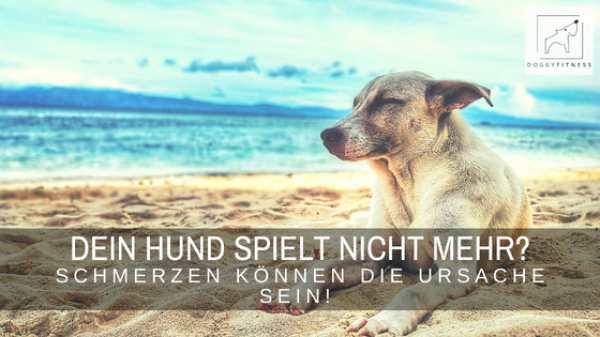Pain in general and also joint pain in dogs is a topic that dog owners are becoming more and more aware of and take seriously. As recently as the 1980s, it was erroneously assumed that dogs felt no pain or only very limited pain. Fortunately, we know better today and can basically deal with the issue better. But did you know that many dogs’ behavior changes when they are in pain? Dog no longer plays
How do our dogs feel pain? Dog no longer plays
The sensation of pain in our dogs is individual. For example, character and constitution have a great influence on how strong or weak a pain is felt by the dog and how high the respective pain tolerance is. Dog no longer plays
How do dogs feel when they are in pain?
As a dog physiotherapist, I am primarily focused on the musculoskeletal system of the dog. That is why this is the focus of the article here. But in principle, of course, this applies to the entire body of the dog. When a dog is in (joint) pain and suffers from a musculoskeletal condition, it greatly affects how it feels physically, how it feels about its body and how it trusts its own body. Our dogs are no different in such a situation than we humans are.
The dog spares itself from a certain pain intensity and tries – if we consider now purely the musculoskeletal system – to carry out movements only as far as it is bearable for him. To compensate, he subsequently puts more strain on other parts of the body.
Of course, this has consequences. Less load and movement mean a loss of muscle and poorer nutrition of the joint and articular cartilage. Osteoarthritis is preprogrammed. The other joints, which are now overloaded, are also quickly at risk of developing osteoarthritis. In addition, there is tension in the muscles. The dog is in a vicious circle. The pain itself becomes a clinical picture. Dog no longer plays
However, pain in dogs does not only have physical effects. His daily life and quality of life are also affected to a greater or lesser extent. Thus, pain not only affects the body, but also the dog’s behavior and routines.
Your dog does not play anymore? Pain can be the cause!
If something hurts the dog, especially if we talk about a chronic pain, behavioral changes occur over time. He may become grumpy, withdrawn, in a bad mood, and more likely to react irritably in social interactions
Even playing often loses its fun dog no longer plays
With dogs that have always loved to play – whether with other dogs or with people – and suddenly stop doing so, you should be alarmed. Sure, when dogs are young, they usually play more and as they age, their playfulness diminishes. But if a dog quite suddenly no longer enjoys playing with other dogs, or even avoids them, you should take this seriously.
Often there is pain behind it. It is possible that the dog suffers permanently from a pain, or certain movements during play cause it and therefore he goes into avoidance behavior.
The causes can be manifold. If you look only at the musculoskeletal system, it could be osteoarthritis, spondylosis or hip dysplasia, for example, or nerve pain triggered by disc problems or cauda equina. This list could be continued at will and can of course also concern the organs.
In any case, I recommend you get to the bottom of the cause and take away your dog’s pain if that is the cause of the behavior change.
PS; Here you can find 21 different signs that dogs show when they are in pain.
Has your dog ever been in pain or does he chronically suffer from it, if applicable? Does(e) he also show less or no more need to play or other behavioral changes?
Feel free to share your experiences with me in the comments!
Would you like to learn more about pain in dogs and how to reliably recognize signs of pain? Then join my free online mini course “Recognizing signs of pain in dogs – incl. Checklist”!
All the love, your Tina
Dieser Beitrag ist auch verfügbar auf:
Français (French)
Deutsch (German)
Español (Spanish)
















